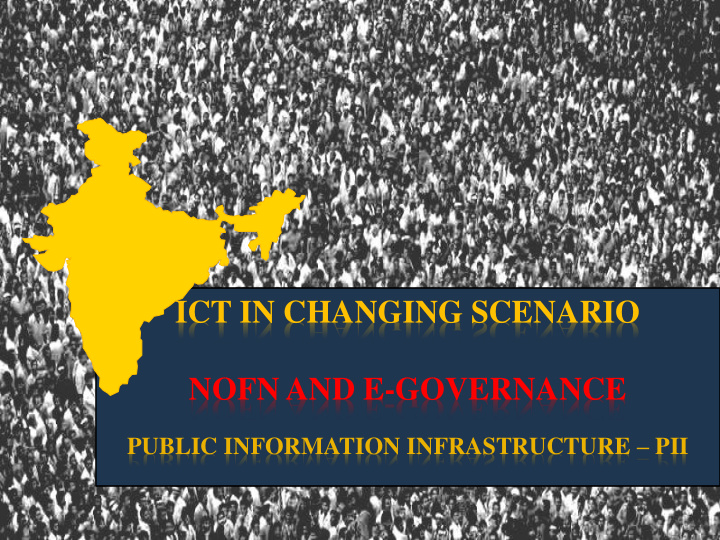



ICT IN CHANGING SCENARIO NOFN AND E-GOVERNANCE PUBLIC INFORMATION INFRASTRUCTURE – PII
Rapid change in expectation of common man Desire to move to information society Desire to participate in governance and development process Desire to participate in knowledge economy
Rapid Technology change Leading to annihilation of time and distance Ability to store huge amount of data on-line Ability to on-line search through large volume of information Convergence of media (audio. Video, text etc) Rapid Access of technology to common man Awareness and education to common man
Moving the society to horizontal structure From the present vertical structure From top down to bottom structure Need for OPEN Government
Initiative in India Towards Open Government. Policy Initiatives for Open Government Right to Information Act – 2005 (RTI) RTI includes right to ; -Inspect works, documents, records; -Take notes, extracts or certified copies of documents or records; -Take certified samples of material; -Obtain information in Electronic form.
a. Right to Information Act - 2005 Negative list: - Sovereignty & Integrity - Forbidden by Court of Law - Breach of Privilege of Parliament - IPR - Confidentiality of Foreign Government Document - Endanger life or physical security - Personal information with no relation to public activity
b. Citizen’s/Client Charter and Public Grievance Redressal . It is a written declaration by a Government Department for defining service delivery standards, Create a system to implement, monitor and review Citizens Charter. Create a system to redress and monitor Public Grievance
c. National Policy for Data Sharing and Accessibility Indian Cabinet has asked Department of Science & Technology to develop a policy frame work for sharing and accessibility of data. Five Working Groups have been set up; - Technology for Sharing and Access. - Current Legal Framework - Data Classification - Global Best Practices for Data Standards - Costing and Pricing Policy
D- governance initiatives 1 Data centres- (National and State Level)_ 2 Sevice delivery Centres 3 Networks State based networks National network NOFN National Knowledge Network
All 3 Pillars of Government are focused on speedy Implementation Across 35 States & Union Territories – multiple establishments & multiple channels for delivery of public services need Re-engineering Executive Legislature Judiciary GOVERNMENT
However, there are substantial Challenges in Implementation ► Fragmented structures ► Archaic processes ► Lack of co-ordination and communication ► Lack of Transparency, Accountability & Clarity ► Duplication of Efforts, Conflicting Priorities & Increasing Costs ► Inadequate trained manpower ► Inadequate Local self government ► Pendency in Judicial system ► Poor Infrastructure & Connectivity ► Increased threat of Security, Safety & Disaster ► Increasing Citizen expectations Unified Information Infrastructure will expedite implementation
In the 21 st century – Information will be the fourth pillar of democracy Information as lever of Economic and Social Development Information available in real time to share, manage & collaborate - accurate, reliable, timely & Executive Legislature Judiciary Information usable FUTURE OF GOVERNANCE Government control of strategic information - critical
Strengthening the Fourth Pillar of Democracy requires PUBLIC INFORMATION INFRASTRUCTURE (PII) to ► Create - access, connectivity, systems, processes, programs, structures, standards & platform ► Integrate - geographical (Centre/State) & sectoral (agriculture, transport, finance etc.) boundaries & applications into Single-Secure National Information INFORMATION Space
Why Public Information Infrastructure? Information is a “public good” / “merit good” Will bring Technology and People together on an equitable/inclusive platform Radicalize democracy through informed citizen participation Improve delivery of & access to public services Empower local governance & community institutions Enhance Equity & Efficiency Public information infrastructure will transform India’s 1.2 billion people into 1.2 billion “opportunities”
PII will connect Government & Citizens Internet ICT Network Citizen Government Applications & Platform Cyber Security PUBLIC INFORMATION INFRASTRUCTURE
Multiple Platforms Needed PAYMENT APPLICATION SECURITY GIS UID BROADBAND VOICE
NOFN Broadband Connectivity to 250,000 Panchayats ► Densify fiber on existing CPSU fiber (3,00,000 Rkm) to provide reach in each village Panchayat and provide active infrastructure at GP (ONT + UPS + Solar Panel + WiFi) ► All Fiber & Towers assets have been mapped on GIS ► In the interim provide 100 mbps connectivity to Panchayats ► Connect all blocks to districts with 1 gbps and integrate with NKN, building a nation wide government CUG
Connectivity to Panchayats 3 tier structure Primary Core Network up to Districts at 1+1 gbps Core Network at Secondary Sub district Level with 1 Gbps Tertiary Edge and access network 100 mbps With hot spots at panchayat Last mile cable TV
PII – NATIONAL DATA CENTERS ► Enable Standardized Development/ Deployment platform ► Create Disaster recovery and Business continuity plan ► Ensure Co-hosting / Co-Location for hosting of Application/ Data ► Undertake consolidation of Data Centres ► Create Managed Data Center facilities ► Provide Information repository ► Create Data mining capabilities
PII – All DATA CENTERS ► Total Data Centers: 39 ► 35 States have individual Data Centers in different stages of operations ► 4 National Data Centers to manage operations State Data Center National Data Center Need to harmonize & standardize Data Center creation & operation
PII – APPLICATION PLATFORM BPL Call Centers NREGA Service Delivery Platform Portals Entitlement Payments Registration IVRS PDS Mobile Pseudo Certificates Verification Documents Core Banking (Birth/ Death, RSK Income,..) Touch Land Records Screens UID Delivery platform Property Facilitation Registration Counters A bridge between the citizen and the services – Device & Network agnostic
PII for the people
Recommend
More recommend